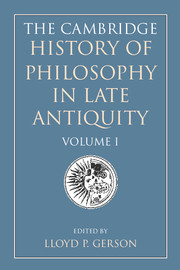Book contents
- Frontmatter
- General introduction
- I Philosophy in the later Roman Empire
- II The first encounter of Judaism and Christianity with ancient Greek philosophy
- III Plotinus and the new Platonism
- IV Philosophy in the age of Constantine
- Introduction to Part IV
- 20 Philosophy in a Christian empire: from the great persecution to Theodosius I
- 21 Themistius
- 22 The Alexandrian school. Theon of Alexandria and Hypatia
- 23 Hierocles of Alexandria
- V The second encounter of Christianity with ancient Greek philosophy
- Map 1 The Byzantine Empire, c. 500
20 - Philosophy in a Christian empire: from the great persecution to Theodosius I
from IV - Philosophy in the age of Constantine
Published online by Cambridge University Press: 28 May 2011
- Frontmatter
- General introduction
- I Philosophy in the later Roman Empire
- II The first encounter of Judaism and Christianity with ancient Greek philosophy
- III Plotinus and the new Platonism
- IV Philosophy in the age of Constantine
- Introduction to Part IV
- 20 Philosophy in a Christian empire: from the great persecution to Theodosius I
- 21 Themistius
- 22 The Alexandrian school. Theon of Alexandria and Hypatia
- 23 Hierocles of Alexandria
- V The second encounter of Christianity with ancient Greek philosophy
- Map 1 The Byzantine Empire, c. 500
Summary
PORTRAITS OF POWER
In the Piazza San Marco, attached to the great basilica’s façade, is a porphyry statue of four tetrarchs, the Emperor Diocletian (284–303) and his three co-regents. Carved in Nicomedia c. 300 ce and transplanted by Venetian Crusaders, the four armour-clad figures in imperial purple stone are locked in a tight embrace, grizzled senior emperors clasping their junior colleagues. They portray the grim resolve with which Diocletian’s inspired concept of divided rule met the tumultuous third century’s military and political challenges, subduing Persians, beating back Germans and Sarmatians on the Rhine and Danube frontiers, and preserving comity among the regents through an artful series of marriages. Apportioning responsibility for territorial defence and administration among two Augusti (senior emperors) and their junior colleagues (Caesars) directed imperial attention to simultaneous problems in far-flung regions in a way impossible when one man ruled. Now Roman emperors governed from Trier, Milan, Nicomedia and Antioch. Simultaneously, through marriages and religious titles, Diocletian’s system staunched the problem of rivalry and usurpation which had plagued his predecessors across the past half century: the senior Augustus, Diocletian, was ‘Jovius’, literally the son of Jupiter; his co-Augustus, Maximian, was ‘Herculius’, the son of Hercules (Jupiter’s legendary half-human son). As Caesars, the Jovian Galerius and Herculian Constantius each married their senior partner’s daughter. Such alliances discouraged challenges to the senior tetrarchs; concurrently an effort to promote the emperors as the embodiments or images of the gods for whom they were named (see, for example, PL 10.2.1, 4.2, 3.5) built upon the emperor Aurelian’s earlier efforts to link himself to a divine, protective companion, elevating him safely beyond any challenger’s reach. After he came to see himself as champion of the Christian god, the emperor Constantine (306–37) discarded the divine Roman imperial names.
Keywords
- Type
- Chapter
- Information
- The Cambridge History of Philosophy in Late Antiquity , pp. 376 - 396Publisher: Cambridge University PressPrint publication year: 2000



